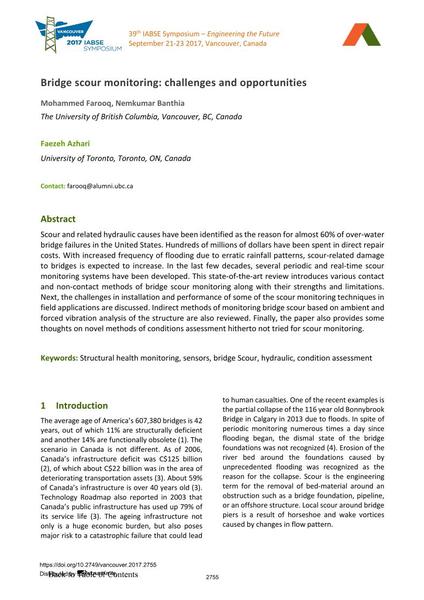Bridge scour monitoring: challenges and opportunities

|
|
|||||||||||
Détails bibliographiques
| Auteur(s): |
Mohammed Farooq
(The University of British Columbia, Vancouver, BC, Canada)
Faezeh Azhari (University of Toronto, Toronto, ON, Canada) Nemkumar Banthia (The University of British Columbia, Vancouver, BC, Canada) |
||||
|---|---|---|---|---|---|
| Médium: | papier de conférence | ||||
| Langue(s): | anglais | ||||
| Conférence: | IABSE Symposium: Engineering the Future, Vancouver, Canada, 21-23 September 2017 | ||||
| Publié dans: | IABSE Symposium Vancouver 2017 | ||||
|
|||||
| Page(s): | 2755-2762 | ||||
| Nombre total de pages (du PDF): | 8 | ||||
| Année: | 2017 | ||||
| DOI: | 10.2749/vancouver.2017.2755 | ||||
| Abstrait: |
Scour and related hydraulic causes have been identified as the reason for almost 60% of over-water bridge failures in the United States. Hundreds of millions of dollars have been spent in direct repair costs. With increased frequency of flooding due to erratic rainfall patterns, scour-related damage to bridges is expected to increase. In the last few decades, several periodic and real-time scour monitoring systems have been developed. This state-of-the-art review introduces various contact and non-contact methods of bridge scour monitoring along with their strengths and limitations. Next, the challenges in installation and performance of some of the scour monitoring techniques in field applications are discussed. Indirect methods of monitoring bridge scour based on ambient and forced vibration analysis of the structure are also reviewed. Finally, the paper also provides some thoughts on novel methods of conditions assessment hitherto not tried for scour monitoring. |
||||
